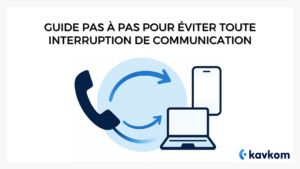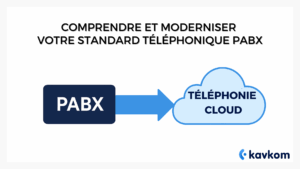A multiline switchboard meets this simple need: to be able to receive several calls simultaneously while keeping a single contact number for your customers. It’s like switching from a single-lane road to a multi-lane freeway: traffic flows more smoothly, and traffic jams disappear.
In this guide, you’ll discover what a multiline phone system is, how it works on a day-to-day basis, and why it becomes essential as your business grows. We’ll also look at its advantages and limitations, the criteria that count when choosing the right solution, and finally the practical steps involved in deploying it in your business.
Points to remember :
- A multi-line switchboard lets you receive several simultaneous calls on a single number, where a single line quickly becomes saturated.
- It improves thecustomer experience by reducing waiting times and quickly directing each caller to the right person.
- Operation is based on three pillars:architecture (VoIP, SIP), routing and reception (IVR, queues) andhosting (on site or in the cloud).
- The cloud model stands out for its flexibility: rapid activation, on-demand line additions, continuous updates and CRM integrations.
- Multiline is ideal for both VSEs and SMEs, when the risk of a busy line becomes an obstacle to customer relations.
Definition: what is a multiline switchboard?
A multiline switchboard is a telephony system designed to handle several communications in parallel on the same number. This means that one call no longer blocks the line. Several employees can answer, transfer or put a call on hold at the same time.
In this way, the company maintains a professional image: a single number displayed for customers, but several phone lines ready to absorb the volume.
Why is it useful?
Without a multiline system, a single call can monopolize the line, leaving other customers waiting in a vacuum. With a multiline system, everyone picks up on their own line, while maintaining consistency: it’s always the company number that’s displayed.
- Without multiline: one call = line busy = customers lost.
- With multiline: several calls at the same time = distributed among employees = better customer experience.
For whom?
Multiline telephony is for all organizations that exceed a minimum volume of simultaneous calls. A small business with three employees, an SME with customer support, a medical practice with a busy reception desk: as soon as the risk of a “busy line” exists, multiline telephony becomes an asset.
How does a multiline telephone system work?
A multiline telephone system may sound technical, but the idea is simple: it receives calls, organizes them and distributes them. Like a hotel switchboard directing visitors to the right room, but on a voice scale.
There are three key elements to understand: architecture, routing and hosting.
Architecture and key concepts
Everything starts with VoIP (Voice over IP). In concrete terms, voice is no longer transported over the old copper network, but converted into data that circulates over the Internet. TheSIP protocol serves as a common language between devices and the network.
Each telephone number corresponds to an entry point, often referred to as a DID. Behind it, telephone lines or “channels” can handle several communications at once.
Your employees can pick up the phone from a softphone (PC or mobile application) or, if they wish, via a compatible IP phone – no hardware is required. Everything remains connected to the same telephony system.
Express dictionary
- VoIP (Voice over IP): your voice travels like an email.
- SIP (Session Initiation Protocol): the protocol that gets everyone on the same page.
- DID (Direct Inward Dialing): the number that rings.
Routing and reception
This is the heart of the customer experience. When a customer calls, they enter a defined path: voice greeting, menu of choices, queue, transfer to an available agent.
The interactive voice server (IVR) acts as a gatekeeper. It suggests options (“type 1 for accounting”), then redirects to the right team. Queues absorb the peaks, while the voicemail takes over after hours.
The conference call completes the package: several people can exchange information live, even from a distance.
Call route
- Voice response (IVR).
- Choice of direction.
- Queue if required.
- Available agent picks up.
- Transfer or voicemail as a last resort.
Hosting: on site vs. hosted in the cloud
This is the structural choice.
- With an on-site PBX or IPBX, you install a physical server on your premises. You have to manage maintenance, upgrades and cabling.
- With a cloud-hosted solution, everything runs over the Internet. No hardware to buy, no server to monitor, and continuous updates on the supplier side.
Here again, the trend is clear. The copper network is gradually closing down in France, and voice is shifting to IP. According to Arcep, this is driving companies to migrate to more scalable multiline cloud systems.
Advantages and limitations of a multiline switchboard
A multiline switchboard is a simple answer to a recurring problem: how to handle a large number of calls without losing the thread. It offers real advantages, but also requires a few precautions.
Strengths for the company
The first advantage is flexibility. You can add or remove lines depending on the season or growth. An SME that doubles its workforce no longer needs to reinstall everything, it simply activates new channels.
Second advantage:scalability. Multiline grows with your business. Whether you receive ten or a hundred incoming calls, the system keeps pace.
Third point: mobility. Your teams can pick up the phone from a landline, computer or cell phone. Everything is centralized, but everyone answers from wherever they are.
Finally, there’s supervision and integration. Managers have access to dashboards, and CRM or ERP tools connect easily to the system thanks to Kavkom’s native integrations (HubSpot, Zoho, Salesforce, Pipedrive, Zendesk, etc.). Kavkom doesn’t replace your CRM, it connects to it. The result: professional telephony that supports both customer relations and internal management.
Benefits
- Multiple calls handled at the same time.
- Telephone lines to suit your business.
- Advanced features such as routing and voicemail.
- A team that works where it wants, without technical constraints.
Points to watch
The quality of communications depends directly on your network. An unstable connection can adversely affect callers‘ experience. That’s why it’s a good idea to check your bandwidth before migrating.
Continuity of service is another matter. If the Internet goes down, you need to have a back-up plan in place: redirecting calls to mobiles, or a backup connection.
Parameterization also needs to be anticipated. An interactive voice server that’s too complicated can put customers off. It’s better to keep things simple, with few options and clear messages.
Finally, think about human support. Multiline changes habits. Train your teams, explain the benefits and establish usage rituals to avoid resistance.
Vigilance checklist
- VoIP-ready Internet network.
- Redundancy in case of failure.
- Short, straightforward telephone greeting.
- Quick training for your employees.
Comparison: traditional switchboard vs. cloud telephony solution
When it comes to multiline switchboards, there are often two opposing models: the traditional system installed on the premises, and the cloud solution hosted online. Both perform the same function, but with radically different logics.
Traditional systems
A traditional PABX or IPBX relies on hardware installed in your offices. You need cabling, extension cards to add lines, and often a maintenance contract.
These systems have long been the norm. But their rigidity weighs heavily on companies: every change requires technical intervention, and costs mount up.
Cloud solutions
The cloud has changed the game. There’s no need for a physical box: everything is hosted by the provider. You connect via the Internet, and your employees use a softphoneor IP phone connected to the network.
The benefits are immediate: rapid activation, adding or removing lines in just a few clicks, and continuous updates. Integration with CRM or business tools is a matter of course.
Cost, scalability and integration
| Criteria | Traditional switchboard (PABX/IPBX) | Cloud solutions |
|---|---|---|
| Installation | Hardware installation, cabling, heavy parameterization | Simple activation, no local server |
| Costs | Initial investment + maintenance | Flexible pro rata billing, with no commitment and no minimum duration. |
| Scalability | Adding maps and technical interventions | Add lines instantly |
| Mobility | Use limited to wired substations | Use on PC, cell phone, IP phone |
| Integrations | Specific and costly | Native connectors to CRM/ERP |
| Supervision | Optional modules | Integrated dashboards |
| Continuity | Site-dependent | Operator redundancy on the cloud side |
Selection criteria: how to choose the right multiline telephone system?
There are four key criteria for choosing the right multiline system for your business: capacity, functionality, integration and security.
Capacity and scalability
The first point is to know how manysimultaneous calls your organization needs to handle. A small business may be satisfied with a few lines. An SME with customer support will need dozens of channels.
The important thing is to choose a solution that gives you the freedom toadd or remove lines over time. In this way, you can adapt your system according to growth or seasonality.
Checklist: how many lines do you need?
- Average number ofincoming calls per day.
- Hourly peaks (e.g. 10 a.m. and 3 p.m.).
- Percentage of simultaneous calls.
- Staffing expected in one year’s time.
- Percentage of seasonal or temporary workers.
Features to check
A good multiline switchboard doesn’t just take multiple calls. It must also offer advanced features that make the experience more fluid.
Among the most useful: interactive voice response (IVR), voicemail, call transfer, queuing,recording and follow-up statistics.
Practical checklist: telephony features you must have
- Single IVR, maximum 3 options.
- Queues with automatic callback.
- Customizable voicemail.
- Hot transfer (talk to a colleague before making the call).
- Recording can be activated on demand.
- Readable statistics on a dashboard.
Integrations and APIs (CRM/ERP)
Your corporate telephony system needs to speak the same language as your other tools. Otherwise, you’re wasting time on double-entry.
CRM or ERP integrations make life easier: a click-to-call from the CRM, a customer file that opens automatically when the number rings, or direct export to your analysis tools.
Map of possible integrations
- Sales CRM (HubSpot, Salesforce): click-to-call, file feedback.
- Customer service (Zendesk, Freshdesk): number linked to the ticket.
- ERP: centralization of accounting and customer data.
- BI (Power BI, Looker): export call statistics.
Security, compliance and hosting
Last but not least: security. Calls must be encrypted, access controlled, and RGPD compliance respected.
The recording oftelephone calls is possible, but subject to precise rules. The CNIL (French Data Protection Authority) has set a limit on the length of time calls can be kept (generally six months for internal use, one year for analysis).
Compliance box: what does the CNIL say?
- Clearly inform the caller of the recording.
- Define a legal basis (contract, consent, legitimate interest).
- Limit storage: six months internally, one year for analysis.
- Restrict access to authorized persons.
A good multiline switchboard needs to bring all these elements together. And that’s precisely what Kavkom offers with its 100% cloud solution: intuitive IVR, recordings, real-time supervision, clear dashboards, seamless integration with your CRM and French-speaking human support, available every step of the way.
Deployment: multiline telephony for your business in 4 steps
Setting up a multiline switchboard may seem complex. In reality, there are four simple steps. The idea is to start with your real needs, then move forward in stages.
1) Assess your needs
Before installing anything, take the time to map your inbound and outbound calls. How many per day? What are the peak times? Which teams have to answer?
A medical practice, for example, receives most of its calls between 8 and 10 am. An e-commerce SME, on the other hand, sees its lines saturated at the end of the day with customer support. This data directly guides the choice of system.
Needs assessment checklist
- Average daily call volume.
- Identified hourly peaks.
- Percentage of simultaneous calls.
- Number of connected employees.
- Sites or antennas to be covered.
2) Choose and configure your cloud solution
Once your needs have been defined, it’s time to configure your multiline telephony. You assign your telephone numbers, define call plans and set up the interactive voice server (IVR).
The advantage of the cloud is immediate : no complicated wiring, everything can be set up from a web interface. You can activate new lines in just a few minutes, and test the call path before opening it up to your customers.
Key configuration steps
- Select main and secondary numbers.
- Set up the IVR with a simple menu (max. 3 choices).
- Create user profiles by department.
- Test scenarios (transfer, voicemail).
3) Train the team and connect the CRM
Even the best system is useless if your employees don’t use it properly. A quick training session is all it takes to show them how to pick up, transfer or put a call on hold.
This is also the time to plug in CRM integrations. When a customer calls, the record opens automatically. Agents have context and save time.
Express training plan
- 30-minute practical demonstration.
- Memo cards: transfer, hold, record.
- 3 calls listened to with feedback.
- Statistics follow-up at team briefing.
4) Continuous control and adjustment
Commissioning is just the beginning. Every week, check the dashboards to see if the routes are working: average waiting time, pick-up rate, successful transfers.
If you notice a queue that’s too long, adjust the IVR. If a service picks up too slowly, rebalance the distribution. Multiline is alive: it evolves with your organization.
Weekly indicators
- Pick-up rate in under 20 seconds.
- Average waiting time.
- Number of lost calls.
- Percentage of successful transfers on the first try.
FAQ : multiline switchboard
What is a multiline switchboard and how does it work?
It’s a system for managing several calls in parallel on a single number. Calls are distributed to the right people via an interactive voice server, transfers and queues.
What are the advantages of a cloud solution for managing several simultaneous calls?
Cloud telephony offers flexibility: quick activation, adding lines in just a few clicks, easy remote working and real-time supervision. Costs are predictable and evolve with your business.
What are the criteria for choosing the right multiline system?
Look at four points: capacity (how many simultaneous calls), advanced features (IVR, recordings), CRM/ERP integrations, and security (RGPD, encryption).
How do you compare a traditional system with a cloud solution tailored to business needs?
Traditional systems rely on hardware to be maintained, while cloud systems rely on an online hosted infrastructure. The former involves heavy investment, while the latter is quick to deploy and easy to upgrade.
What are the steps involved in deploying and maintaining a multiline system?
Four simple steps: assess your needs, configure the solution, train the team and monitor indicators for continuous adjustment.
Conclusion
A multiline switchboard is not just for large groups. It’s an accessible tool, designed to streamline calls for small businesses and growing SMEs alike.
The logic is still the same: a single number, but several lines, so that each caller quickly finds the right person. Choosing the cloud makes the process even simpler, by removing the burden of hardware.
If there’s one thing you should take away from this guide, it’s this: multiline telephony is first and foremost a way of making customer relations more fluid and teamwork easier. With the right solution, every call becomes a well-managed opportunity rather than a source of stress.





